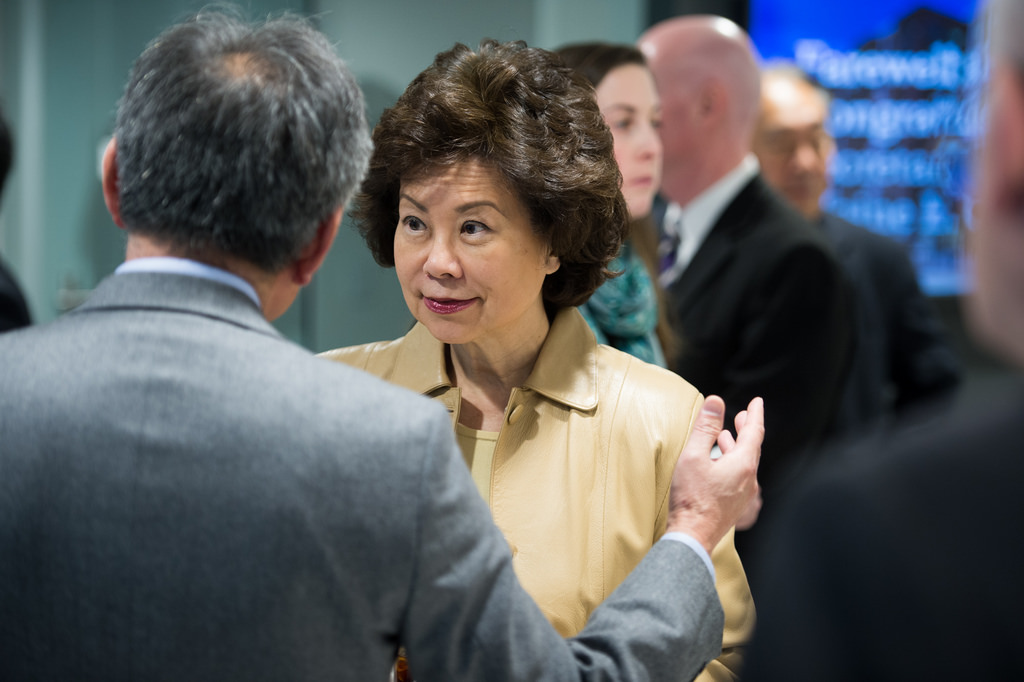Congress began work on Thursday towards drafting a long-awaited infrastructure bill and heard testimony from Transportation Secretary Elaine Chao and the chief of the U.S. Army Corps of Engineers, R.D. James.
“Maybe it’s like the miracle of the loaves and fishes,” Sen. Ed Markey, Democrat of Massachusetts said of the funding plan. “It did work 2,000 years ago, but I just don’t think it’s going to work here.”
The president’s infrastructure outline suggests $100 billion, or half of the direct federal spending, would be used as seed money to incentivize state and local investments. One-quarter of the federal dollars would go towards rural infrastructure. State and local governments are expected to generate the remaining $1.3 trillion.
The proposal left a number of governors shaking their heads after a meeting at the White House in February. Following the meeting, Washington State Gov. Jay Inslee raised concerns that the president’s plan “abandons the federal government’s responsibility” to fund projects and leaves state, local and private interests to pick up more than 85 percent of the remaining costs.
“States cannot and should not bear the burden of building a 21st-century infrastructure system on our own,” Inslee stressed.TweetSen. Tom Carper of Delaware and ranking Democrat on the Senate public works committee, said the governors’ concerns about bearing the brunt of the cost of new infrastructure are understandable. “It’s one of the many places where I think the administration’s math just doesn’t add up,” he said.
At the University of Pennsylvania Wharton School of Business, researchers issued a new report concluding that the president’s rough outline for an infrastructure investment plan would generate a maximum of $30 billion in new infrastructure investment by state, local and private stakeholders.
Based on past evidence, the researchers explained that rather than matching federal funds, states would likely increase infrastructure investment by less than the total amount of federal aid. The final report estimated “that total new infrastructure investment would increase between $20 billion to $230 billion, including the $200 billion federal investment. There will be little to no impact on the economy.”
Chao pointed to the success of the Department of Transportation’s Build America Bureau, where officials have reportedly been leveraging every dollar 40 times, in credit and targeted transportation grants.
Moreover, the administration’s infrastructure plan seeks to spur investment by cutting the costs and reducing the uncertainty surrounding infrastructure investment. By limiting the number of agencies overseeing the permitting process and streamlining projects, the administration anticipates saving billions of dollars in costs. The Department of Transportation estimates that as a result of Trump rolling back regulations during his first year in office, the department will save nearly $800 million in 2017 and 2018.
The president’s plan, Chao said, “is designed to change how infrastructure is designed, built, financed and maintained in communities across the country.”
Other Democratic critics of the plan pointed to the president’s budget, which they say includes deep cuts to existing infrastructure programs.
Sen. Jeff Merkley argued the Trump infrastructure plan amounts to “moving chairs around on the deck of our infrastructure Titanic.”
“That’s a net loss on infrastructure,” Merkley argued. “How does that fulfill the vision of an aggressive infrastructure program?”
Chao responded that the $200 billion in federal seed money is in a different part of the overall federal budget, and disagreed with the senator’s claim that the administration was cutting existing programs.
Other senators clung to the argument that Trump was simply repackaging the $200 billion in budget cuts and branding it as a new infrastructure program.
“It’s a shell game,” Maryland Sen. Chris Van Hollen said.
“They haven’t identified where they’re going to get the $200 billion, then they cut over $200 billion worth of infrastructure in their budget,” he continued. “It’s not even giving with one hand and taking with another. They haven’t given anything yet.”
On the Republican side, lawmakers were more focused on the benefits they expect to accrue as a result of cutting regulations, rather than the federal government’s share of new infrastructure investment.
“This whole idea of the funding for infrastructure in some ways can be a function and will be a function of how aggressively we address permitting reform,” Sen. Dan Sullivan of Alaska stated, adding that being able to fast-track projects will be a “driver” for private sector investment.
Reducing the approval time for a given project is expected to reduce the costs of projects. The Department of Transportation estimates that every year a project is delayed because of the permitting process, or environmental impact studies, there is a 3 percent increase in the total cost.
The first hearing on the president’s infrastructure proposal did not produce much bipartisan agreement, though lawmakers are still hopeful.
“The time has come to make a significant investment in our roads, bridges, ports and water systems,” committee chairman John Barrasso of Wyoming said. “I believe we can work in a bipartisan way on legislation that will make our infrastructure even better.”
The timeline for the bill was called into question earlier this week when Republican Whip John Cornyn threw cold water on the idea of getting an infrastructure bill passed in 2018. Citing time constraints, Cornyn told reporters that he doubted the Senate would have time on the legislative calendar “to get to that.”
On Thursday, Cornyn revised his outlook saying he would push to get an infrastructure bill through the 115th Congress.
“I’m more optimistic than I think my earlier remarks indicated,” Cornyn said. “I just know that the calendar is challenging, but I’m hopeful and I plan to do everything in my power to advance an infrastructure bill this year.”
Still, hammering out the details will be difficult as members struggle to see eye to eye.
They outlined areas of agreement, like providing local and state governments greater autonomy to prioritize projects that will most benefit their communities and finding ways to safely roll back duplicative regulations that add time and money to otherwise sound projects.
“There are many policy areas about which Republicans and Democrats will need to debate and compromise, but that doesn’t deter us,” the two senators wrote. “We believe in getting results for the American people—and that starts with finding common ground.”






